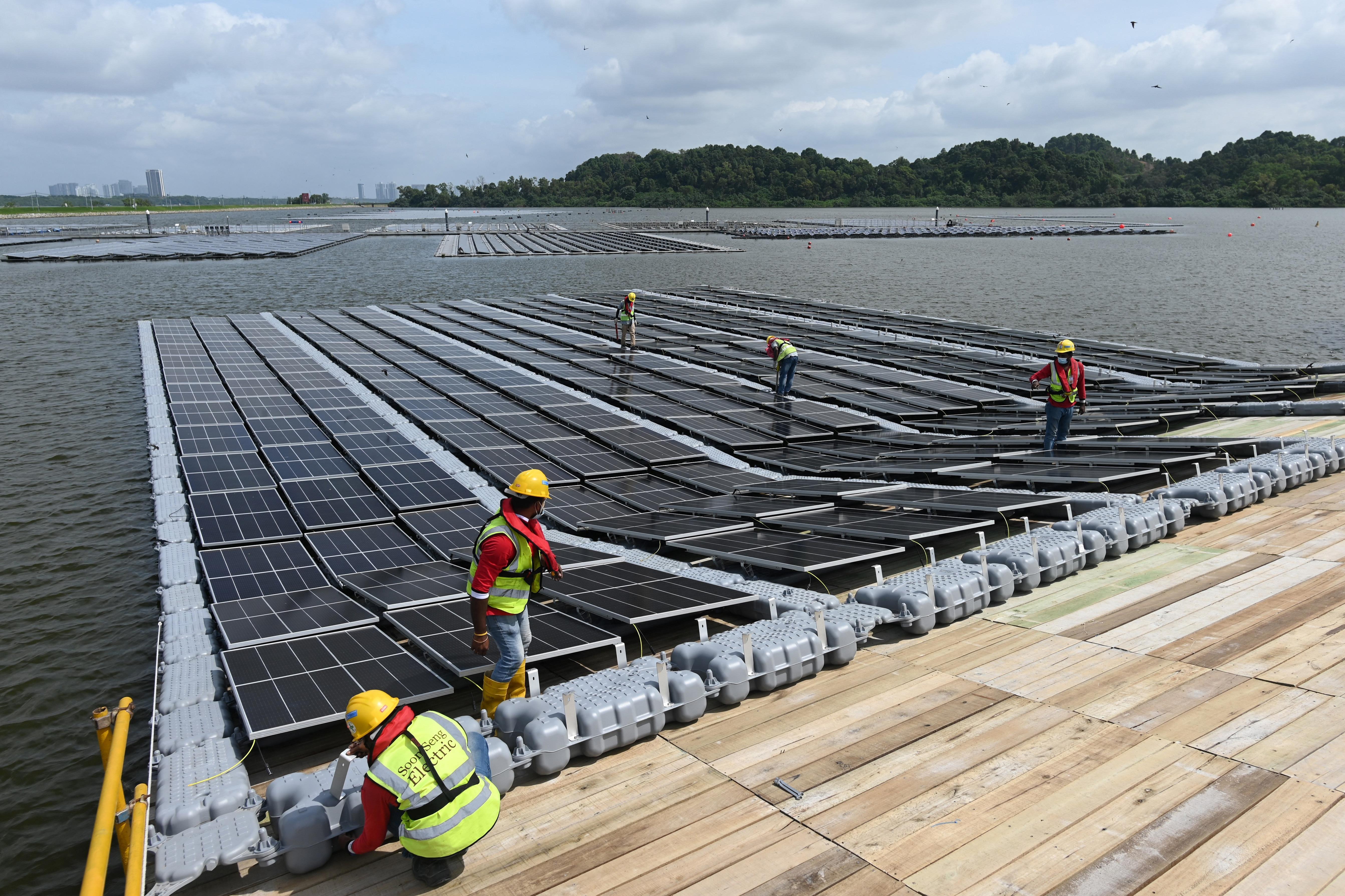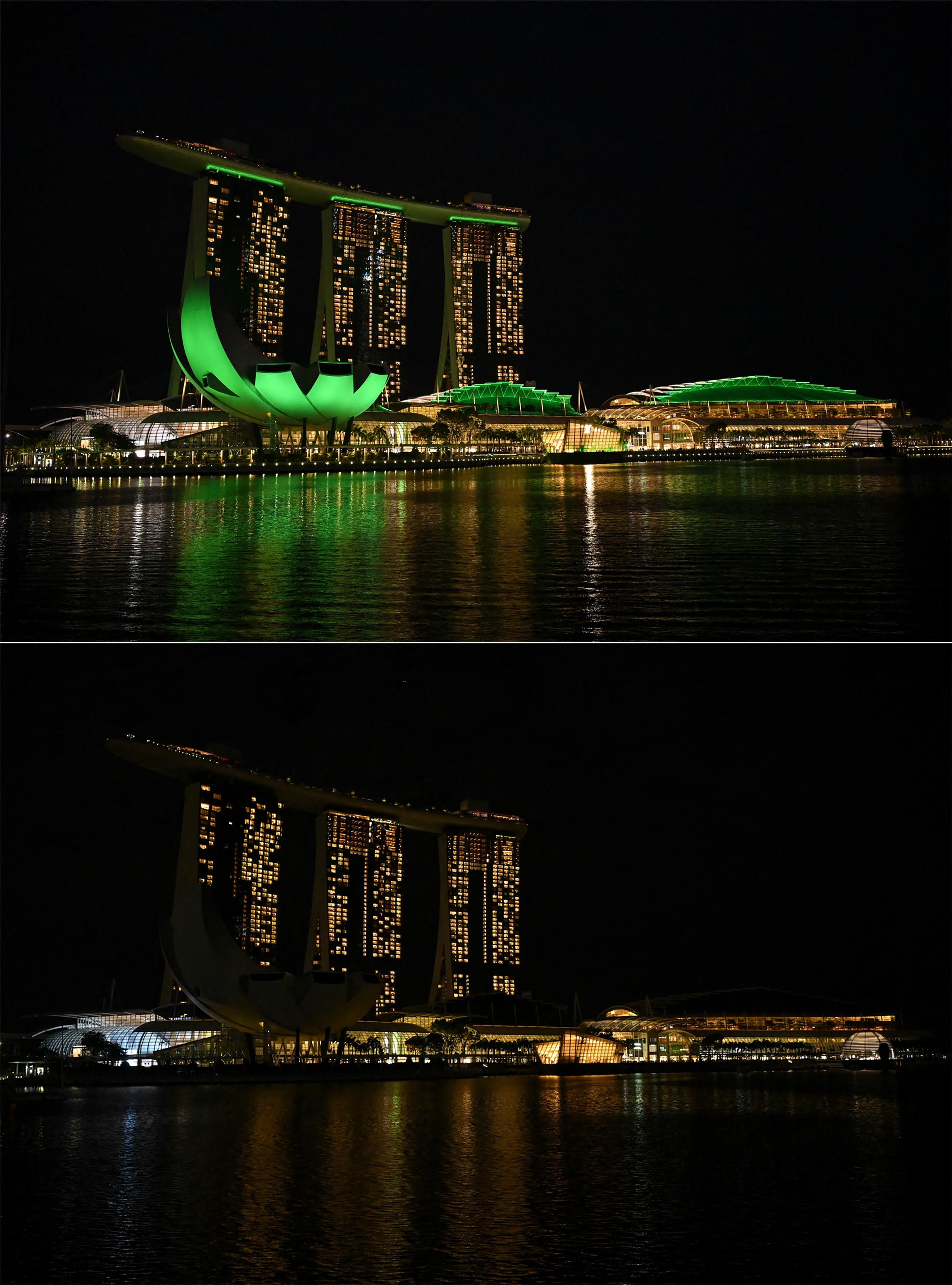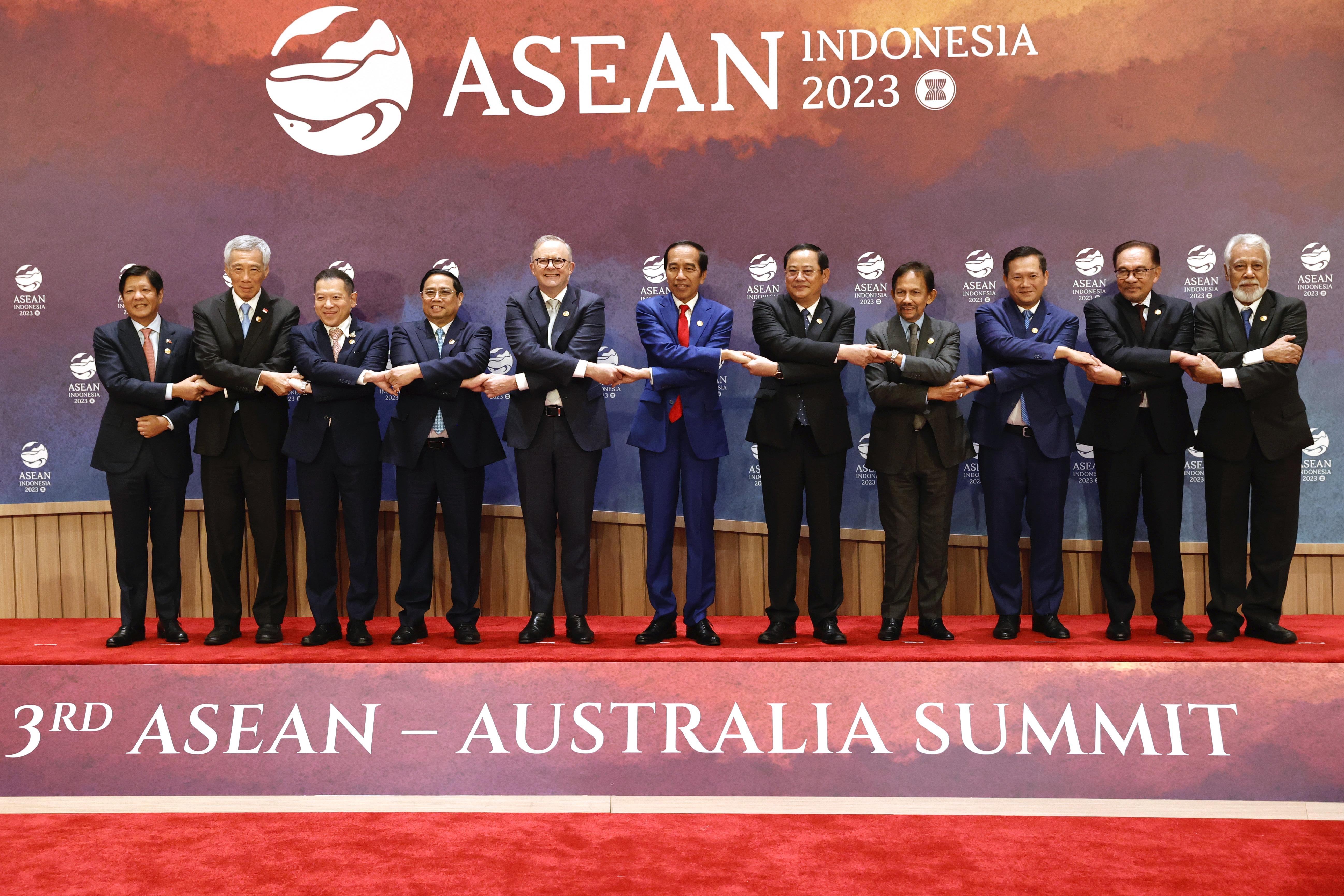 This photograph taken on Feb 3, 2021, shows workers assembling solar panels on the shore of the Tengeh reservoir as part of the construction of a floating solar power farm in Singapore. Thousands of panels glinting in the sun stretch into the sea off Singapore, part of the land-scarce city-state's push to build floating solar farms to cut greenhouse gas emissions. (PHOTO / AFP)
This photograph taken on Feb 3, 2021, shows workers assembling solar panels on the shore of the Tengeh reservoir as part of the construction of a floating solar power farm in Singapore. Thousands of panels glinting in the sun stretch into the sea off Singapore, part of the land-scarce city-state's push to build floating solar farms to cut greenhouse gas emissions. (PHOTO / AFP)
Singapore can serve as one of the global hubs for renewable energy, analysts said, noting that the city-state can leverage its status as one of the world’s biggest commodity trading centers and bunkering ports to achieve that goal.
The need for more renewable energy capacity is crucial in light of the headwinds brought by climate change and geopolitical tension, with the Israel-Palestine conflict seen to disrupt oil supply and spike prices.
Singapore, a signatory of the UN climate pact, has pledged to achieve net zero emissions by 2050. It is also targeting to import 4 gigawatts of clean energy by 2035, accounting for 30 percent of the city-state’s total electricity supply
The 28th United Nations Climate Change conference, to be held from Nov 30 to Dec 12 in Dubai, the United Arab Emirates, has again stressed the urgency of cutting carbon emissions and meeting climate commitments.
READ MORE: S'pore expects economy to improve in second half of 2024
Singapore, a signatory of the UN climate pact, has pledged to achieve net zero emissions by 2050. It is also targeting to import 4 gigawatts of clean energy by 2035, accounting for 30 percent of the city-state’s total electricity supply.
According to Singapore’s National Climate Change Secretariat, as a small, resource-constrained country, Singapore has to import almost all its energy needs, while at the same time exploring a variety of different options, including regional power grids, and emerging low-carbon alternatives such as low-carbon hydrogen and carbon capture, utilization, and storage.
On Oct 24, Singapore’s Energy Market Authority (EMA) gave tentative approval for plans to import 1.2 GW of wind power from Vietnam. Earlier this year, the EMA also approved the importation of solar energy from Indonesia and a mix of hydropower, solar, and potentially wind power from Cambodia.
 This combo picture created on March 27, 2021, shows a general view of the illuminated Marina Bay Sands hotel and resort before (top) and after the lights were turned off (bottom) during the Earth Hour environmental campaign in Singapore on March 27, 2021. (PHOTO / AFP)
This combo picture created on March 27, 2021, shows a general view of the illuminated Marina Bay Sands hotel and resort before (top) and after the lights were turned off (bottom) during the Earth Hour environmental campaign in Singapore on March 27, 2021. (PHOTO / AFP)
The EMA’s announcements have made Singapore “pivotal” in discussions to build a renewable energy power grid in the Southeast Asian region, according to David Broadstock, a senior research fellow and energy transition research lead with the Sustainable and Green Finance Institute at the National University of Singapore (NUS).
READ MORE: China-ASEAN ties to deepen further
He said discussion for a regional power grid among member countries of the Association of Southeast Asian Nations (ASEAN) has been going on for the past few years but lacked the right conditions “to really take that forward”.
However, with Singapore’s push for renewable energy, Broadstock said that it can “play a central role in actually formulating that grid”. He said Singapore, with its strong legal and financial institutions, balanced political environment and business environment, and access to funding and capital makes it an ideal location for a regional power exchange.
READ MORE: Business China Awards honors Singapore-China cooperation
Chan Siew Hwa, co-director of the Energy Research Institute at the Nanyang Technological University, said Singapore is a mix of financial, trading, and transportation hubs and this is why it can facilitate the import and export of energy around the region.
 (From left to right) Philippine's President Ferdinand Marcos Jr., Singapore's Prime Minister Lee Hsien Loong, head of Thailand's delegation Sarun Charoensuwan, Vietnam's Prime Minister Pham Minh Chinh, Australian Prime Minister Anthony Albanese, Indonesian President Joko Widodo, Laos' Prime Minister Sonexay Siphandone, Brunei's Sultan Hassanal Bolkiah, Cambodia's Prime Minister Hun Manet, Malaysian Prime Minister Anwar Ibrahim, and East Timor's Prime Minister Xanana Gusmao hold hands as they pose for a family photo during the Association of Southeast Asian Nations (ASEAN)-Australia Summit, in Jakarta, Indonesia, Sept 7, 2023. (PHOTO / AP)
(From left to right) Philippine's President Ferdinand Marcos Jr., Singapore's Prime Minister Lee Hsien Loong, head of Thailand's delegation Sarun Charoensuwan, Vietnam's Prime Minister Pham Minh Chinh, Australian Prime Minister Anthony Albanese, Indonesian President Joko Widodo, Laos' Prime Minister Sonexay Siphandone, Brunei's Sultan Hassanal Bolkiah, Cambodia's Prime Minister Hun Manet, Malaysian Prime Minister Anwar Ibrahim, and East Timor's Prime Minister Xanana Gusmao hold hands as they pose for a family photo during the Association of Southeast Asian Nations (ASEAN)-Australia Summit, in Jakarta, Indonesia, Sept 7, 2023. (PHOTO / AP)
Singapore is not working alone. “We want to work with our neighbors to strengthen the entire ASEAN position in the world. If Singapore can become a hub, certainly that you will benefit ASEAN as a whole,” Chan said.
Victor Nian, co-founder and CEO of the Singapore-based think tank Centre for Strategic Energy and Resources, said despite its limited land, Singapore could potentially become Asia’s hub for renewable energy as the country has always been open to innovative solutions.
The project, which started its operations in June 2022, has allowed Singapore to import up to 100 megawatts of hydropower from Laos by using existing interconnections in Thailand and Malaysia. This is the first multilateral cross-border electricity trade in ASEAN
He said Singapore is a strategic place for companies and start-ups to pilot new technologies and prove new ideas in renewables. These companies can then venture into neighboring countries to expand their businesses.
Nian said there is a need for ASEAN and Singapore to accelerate their effort in energy transition while recognizing the practical constraints and geopolitical dynamics in the region. Nia cited the initial success of the regional electricity import from Laos to Singapore through the Lao PDR-Thailand-Malaysia-Singapore Power Integration Project.
READ MORE: Laos, Singapore reaffirm partnership in trade, investment
The project, which started its operations in June 2022, has allowed Singapore to import up to 100 megawatts of hydropower from Laos by using existing interconnections in Thailand and Malaysia. This is the first multilateral cross-border electricity trade in ASEAN.
Nian said using renewable energy will continue to pose technical challenges to the power grid due to their intermittency and ASEAN’s need for affordable and reliable baseload supply.
As such, he said nuclear energy and carbon capture should also be included in the roadmap towards national and regional decarbonization goals.
Contact the writer at prime@chinadailyapac.com



